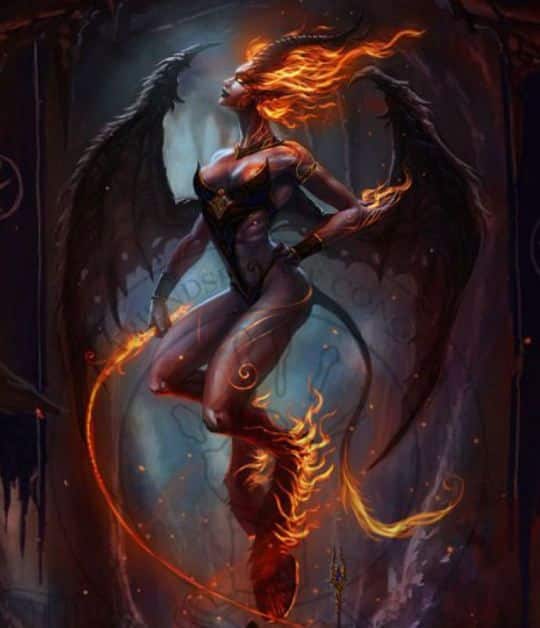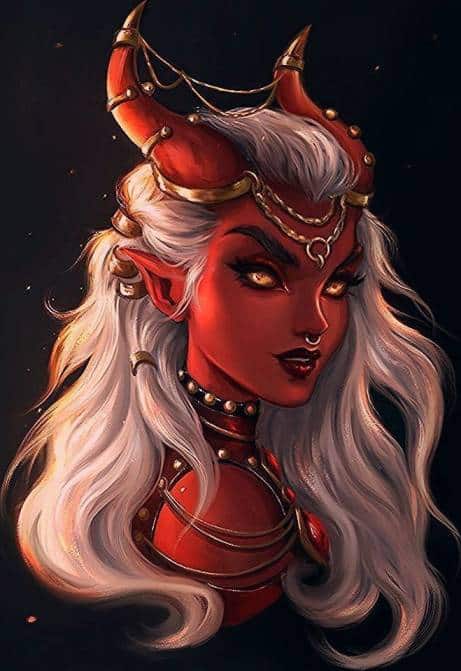The Empusa was one of the more blood thirsty of the ancient Greek monsters. She was a one-legged phantom monster that could assume many shapes in order to lure her victims and devour them. She was a female entity, instructed by the goddess Hecate for vague reasons.
Key Facts
| Parents | Unknown |
| Region | Ancient Greece |
| Siblings | None |
| Offspring | None |
| Names | Empusa or Empousa |
| Ancient Greek | Ἔμπουσα |
Origins of the Empusa

There are only speculations and unreliable assumptions regarding Empusa’s beginning. While some scholars view her as a once beautiful nymph who has fallen out of grace for unknown reasons, others present her as a beast created from the darkness of the earth that hunted young men for their blood and flesh. The mysterious goddess of witchcraft, Hecate, the goddess of magic, was said to control Empusa and send her to haunt the living either to punish the impure in heart or simply to feed.
Etymology
Empusa in ancient Greek means the one-legged woman. The ‘en’ (one) and ‘pous’ (foot) form the compound word Empus for male, and Empusa for female. Hence the one-legged monster that used to spread fear in the ancient world.
Impact
A beast of profound wickedness, the Empusa was regarded with terror in the old days. Her hideous form, but more importantly her thirst for blood was one of the basic elements that helped in the creation of the vampire myth.
The myth of the Empusa

The setting
The ideal time when the Empusa made her appearances were during the moonless nights. Dark, threatening forests and deep harrowing ravines were where she would lie in wait. At the right moment she would reveal her stunning guise and entice unwary men to come closer before sinking her teeth in their flesh.
The beast
The Empusa was a shapeshifting ghost having only one leg either made of brass or a donkey’s leg. This attribute had given her the sobriquet ‘Onoskelis’ (donkey-legged). She had big black eyes and her face and body were hideously deformed from her lust for human blood and flesh.
Fleeting as an evil spirit however, the Empusa would often disguise herself as a beautiful woman with irresistible charm, seeking to lure young men to her bosom and eat them. Her shapeshifting powers and the capacity of changing from the spiritual to the corporeal state made her one of the worst living nightmares of the old world.
The hero
No one has fought with the Empusa and lived to tell the tale. At least, not according to the old texts. Two gods however are said to have faced her and succeeded in eliminating her. One was Hermes, who upon returning from Athens one stormy night met the Empusa at a crossroad. The spirit, misled by the terrible weather, made an attempt against the messenger god, but quick-footed Hermes evaded the attack and turned the monster into a horrifying statue made of marble.
This would have been the end of the monster, but Hecate restored her favourite subject and released her into the world again. This time, the Empusa was more ferocious than before, sneaking in settlements and attacking young men in their sleep. The people prayed to the gods for salvation from this relentless menace and their pleas were quickly answered.
One day, a weary traveller sat down under a poplar tree to have a nap. The Empusa came out of the woods behind him and slowly approached the man. But, no sooner had she made three steps towards him than a lightning bolt was thrown at her. A deafening explosion shocked the area and where she had stood, only a small black crater was smoking now. As the ashes of the dead beast fell to the ground the strange traveller revealed his true form. He was Zeus, the king of the gods, who had smote down the evil Empusa.
Hecate’s influence
Hecate was a chthonic, three-formed goddess that presided over many things such as crossroads, entrance-ways, the Moon, witchcraft, herbs, and necromancy. As a deity of the underworld, Hecate had the power to open and close the gates between life and death. The monsters she commanded shared both natures (living and dead), and were often sent to do her bidding. The Empusa was one of her servants although it is not known how the spectral fiend came under the goddess’ control.
The sisters of the Empusa
The Empusa is often confused with Lamia and Mormolyce or Mormo; other female monsters of the ancient world. At first, Lamia, Libyan Queen who Turned to Child-Devouring Daemon and Mormo were ordinary mortal women, but their fateful transformations and evil deeds, which followed, caused them to become as horrifying as the Empusa. Their eventual physical deaths and the ghost-like standing the people gave to them over the years, made these two monsters to become something like the sisters of the Empusa. They shouldn’t be thought of as the same however as the Empusa, the Lamia and the Mormo are three different things.
Roles and Responsibilities
Fear, horror and gruesome death were the Empusa’s roles. The phantom beast would roam isolated areas searching for men to kill and feed on.
In the old texts
Greek
The Empusa is mentioned in Aristophanes’ plays ‘The Frogs’ and ‘Assemblywomen’.
ΞΑΝΘΙΑΣ: καὶ μὴν ὁρῶ νὴ τὸν Δία θηρίον μέγα.
ΔΙΟΝΥΣΟΣ: ποῖόν τι;
ΞΑΝΘΙΑΣ: δεινόν· παντοδαπὸν γοῦν γίγνεται
τοτὲ μέν γε βοῦς, νυνὶ δ ̓ ὀρεύς, τοτὲ δ ̓ αὖ γυνὴ
ὡραιοτάτη τις.
ΔΙΟΝΥΣΟΣ: ποῦ ̓στι; φέρ ̓ ἐπ ̓ αὐτὴν ἴω
ΞΑΝΘΙΑΣ: ἀλλ ̓ οὐκέτ ̓ αὖ γυνή ̓στιν, ἀλλ ̓ ἤδη κύων.
ΔΙΟΝΥΣΟΣ: Ἔμπουσα τοίνυν ἐστί.
XANTHIAS: My god! Now I see it.
Ooooh, a monstrous beast!
DIONYSUS: What’s it like?
XANTHIAS: It’s weird—all sorts of shapes.
Now it’s an ox—no, no, a jackass—
now it’s a woman—what a gorgeous lady!
DIONYSUS: Where is she? I’ll go say hello.
XANTHIAS: Hold on a minute!
She’s not a woman any more. Now she’s a dog!
DIONYSUS: It’s Empusa!!
Aristophanes’ The Frogs 288-292
Philostratus speaks about the Empusa in his work ‘Life of Apollonius of Tyana’.
‘But on their way to this river our wayfarers found the following incidents worth of notice. For they were traveling by bright moonlight, when the figure of an empusa or hobgoblin appeared to them that changed from one form into another, and sometimes vanished into nothing.’
Philostratus’ Life of Apollonius of Tyana, Chapter IV
Roman
Very few Roman scholars allude to the Empusa in their works.
FAQs
The bloodsucking Empusa was always an appalling monster. There is no telling if she was once a beautiful goddess or a nymph turned into this grotesque apparition.
Hecate was the goddess of witchcraft, crossroads and ghosts in ancient Greece. She was an obscure deity with many followers and a prominent position in every household. Her connection with the Empusa was based on the dark and spiritual nature of the beast. Hecate held dominion over the spirits that traversed the lands of the living. The Empusa was one of them; a strong and dangerous shape-shifting phantom.
Featured Image Credit: greek_br0s
